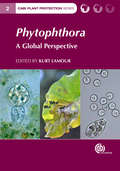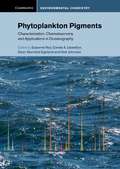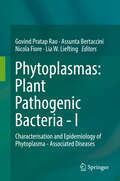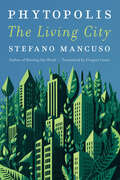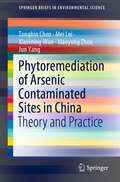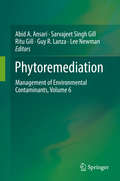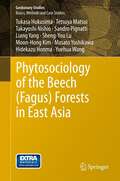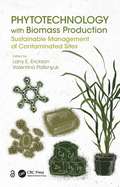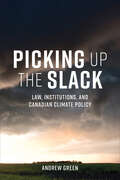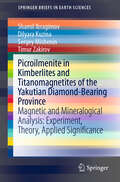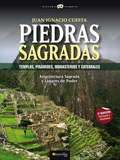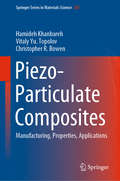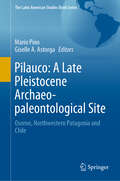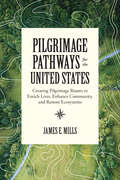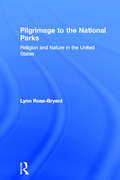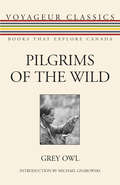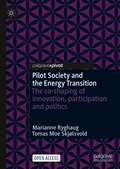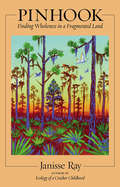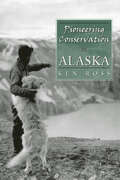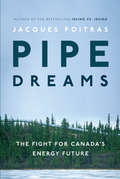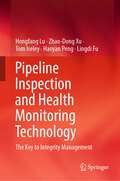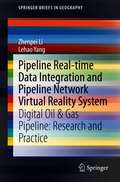- Table View
- List View
Phytophthora
by Frank Martin Greg Forbes Marco Thines Yilmaz Balci Yuanchao Wang Kurt Lamour Sylvia Patricia Fernández Pavía Mary Hausbeck Paul Bosland Thomas Jung Olaf Ribeiro Randy Ploetz Adrienne Hardham Janice Uchida Anne Dorrance Tibor Érsek Jan Nagel Dennis Halterman Soum Sanago Susan Miyasaka David Cooke Andre Drenth Rodrigo Ahumada Sabine WerresMembers of the genus Phytophthora cause serious damage to a huge array of plants. From the nineteenth century Irish potato famine to current widespread threats to forests and ecosystems in North and South America, Europe and Australia, the genus lives up to its reputation as the plant destroyer. This book provides an overview of Phytophthora species impacting crops, forests, nurseries, greenhouses and natural areas worldwide. Chapters cover major hosts, identification, epidemiology, management, current research, future perspectives and the impacts of globalization on Phytophthora. Phytophthora: A Global Perspective is an essential resource for researchers and extension workers in plant pathology and crop protection.
Phytophthora: A Global Perspective (Plant Science / Horticulture Ser. #2)
by Frank Martin Greg Forbes Marco Thines Yilmaz Balci Yuanchao Wang Sylvia Patricia Fernández Pavía Mary Hausbeck Paul Bosland Thomas Jung Olaf Ribeiro Randy Ploetz Adrienne Hardham Janice Uchida Anne Dorrance Tibor Érsek Jan Nagel Dennis Halterman Soum Sanago Susan Miyasaka David Cooke Andre Drenth Rodrigo Ahumada Sabine WerresMembers of the genus Phytophthora cause serious damage to a huge array of plants. From the nineteenth century Irish potato famine to current widespread threats to forests and ecosystems in North and South America, Europe and Australia, the genus lives up to its reputation as the plant destroyer. This book provides an overview of Phytophthora species impacting crops, forests, nurseries, greenhouses and natural areas worldwide. Chapters cover major hosts, identification, epidemiology, management, current research, future perspectives and the impacts of globalization on Phytophthora. Phytophthora: A Global Perspective is an essential resource for researchers and extension workers in plant pathology and crop protection.
Phytoplankton Pigments
by Suzanne Roy Einar Skarstad Egeland Geir Johnsen Carole A. LlewellynPigments act as tracers to elucidate the fate of phytoplankton in the world's oceans and are often associated with important biogeochemical cycles related to carbon dynamics in the oceans. They are increasingly used in in situ and remote-sensing applications, detecting algal biomass and major taxa through changes in water colour. This book is a follow-up to the 1997 volume Phytoplankton Pigments in Oceanography (UNESCO Press). Since then, there have been many advances concerning phytoplankton pigments. This book includes recent discoveries on several new algal classes particularly for the picoplankton, and on new pigments. It also includes many advances in methodologies, including liquid chromatography-mass spectrometry (LC-MS) and developments and updates on the mathematical methods used to exploit pigment information and extract the composition of phytoplankton communities. The book is invaluable primarily as a reference for students, researchers and professionals in aquatic science, biogeochemistry and remote sensing.
Phytoplankton Pigments
by Suzanne Roy Einar Skarstad Egeland Carole Llewellyn Geir JohnsenPigments act as tracers to elucidate the fate of phytoplankton in the world's oceans and are often associated with important biogeochemical cycles related to carbon dynamics in the oceans. They are increasingly used in in situ and remote-sensing applications, detecting algal biomass and major taxa through changes in water colour. This book is a follow-up to the 1997 volume Phytoplankton Pigments in Oceanography (UNESCO Press). Since then, there have been many advances concerning phytoplankton pigments. This book includes recent discoveries on several new algal classes particularly for the picoplankton, and on new pigments. It also includes many advances in methodologies, including liquid chromatography-mass spectrometry (LC-MS) and developments and updates on the mathematical methods used to exploit pigment information and extract the composition of phytoplankton communities. The book is invaluable primarily as a reference for students, researchers and professionals in aquatic science, biogeochemistry and remote sensing.
Phytoplasmas: Characterisation And Epidemiology Of Phytoplasma - Associated Diseases
by Assunta Bertaccini Govind Pratap Rao Nicola Fiore Lia W. LieftingPhytoplasma-associated diseases are a major limiting factor to quality and productivity of many ornamentals, horticultural and other economically important agriculture crops worldwide. Annual losses due to phytoplasma diseases in many crops vary, but under the pathogen favorable conditions they always lead to disastrous consequences to farming community. As there is no effective cure for phytoplasma diseases, the management options emphasize on their exclusion, minimizing their spread by insect vectors and propagation materials and on development of host plant resistance. The phytoplasma associated plant diseases have a history of more than 50 years. Phytoplasmas have undoubtedly infected plants and cause diseases for centuries before they are described and proven to be the causal agents. But important progress related to identification of phytoplasmas only began after 1980’s. Phytoplasmas have emerged as the most serious constraints in the production of several crops all around the world during last four decades. Phytoplasmas constitute a major limiting factor to quality and productivity of cereals, horticultural, ornamentals and many other economically important crops all over the world. Annual losses due to phytoplasma diseases may vary, but under the pathogen favorable condition, phytoplasma disease may lead to disastrous consequences for farming and industry community. The scientific literature concerning phytoplasma occurrence, characterization, diagnosis, detection, and management is growing at a fast pace. Significant advancement in the last decades on diagnostic, biological and molecular properties, epidemiology, host-pathogen-insect interactions as well as management of phytoplasmas has been made. Till date, no authentic compilation is available to know the progress of phytoplasmas characterization major crops all over the world. The planned book will compile all the updated information available information on phytoplasmas by distinguished experts in the form of edited book entitled “Characterization and epidemiology of phytoplasma associated diseases”. The book covers recent and update information on emerging and re-emerging phytoplasma diseases affecting important crops in tropics and subtropics. It provides comprehensive information on disease distribution, occurrence, and identification of the phytoplasmas including the recent approaches for diagnostics, transmission, and information about losses and geographical distribution along with and management aspects. This volume contains 11-12 chapters contributed by the experienced and recognized experts working on different group of phytoplasmas affecting major crops all over the world. The information on various topics is at advanced as well as comprehensive level and provides the period wise developments of phytoplasma research. The book covers major chapters on an up to date progress of phytoplasma research, and then phytoplasma diseases associated with vegetable, pulse, oils crops, cereals, sugar crops, fruit crops, ornamentals, medicinal plants, palms species, forest tress and weeds. We have covered historical background, geographical distribution, identification and characterization, genetic diversity, host pathogen interaction and management aspects of important phytoplasma diseases infecting our major agricultural crops. The information on various topics is advanced as well as comprehensive, and provides thought provoking ideas for planning novel research ideas for future. This book will be useful to everyone interested in mollicutes, phytoplasma, spiroplasmas, plant pathology, disease control and plant biology and serve as an exhaustive and up-to-date compendium of references on various aspects of different groups of phytoplasmas affecting important crops worldwide.
Phytopolis: The Living City
by Stefano MancusoA renowned plant expert explains how we can make urgent, positive changes to our cities that protect against and reduce global warming.The conquest of new lands has been the greatest occupation of our species: for hundreds of thousands of years, humans have searched for new territories to inhabit, finding in the city the best place to live in the last hundred years. Looking at the parabola of our geographical expansion, it appears that humans have gone from being a generalist species, capable of colonizing any environment, to very quickly becoming a specialized species, capable of thriving only within a particular habitat. The city seems to have become the only place where we can expect to thrive and reproduce, because it is the only place where our specialization gives us the best chance of survival, and quality of life.However, &“species specialization&” is effective only in a stable environment: in changing environmental conditions, it becomes dangerous. And if the resources the city needs to thrive are not unlimited, global warming can permanently change the environment of our cities—an event that would be fatal. But it is the city itself, as it is today, that is the main driver of environmental destruction. Humankind is confronted with a paradox: we must rethink our cities and make them a lasting ecological niche.In this clear, accessible, and fascinating work, Stefano Mancuso proposes a green solution: how would our cities be transformed if their framework were modeled on plants?
Phytoremediation of Arsenic Contaminated Sites in China: Theory and Practice (SpringerBriefs in Environmental Science)
by Jun Yang Tongbin Chen Mei Lei Xiaoming Wan Xiaoyong ZhouThis book introduces readers to the main theories of phytoremediation and its application to arsenic-contaminated soils in China. The hyperaccumulation theories are introduced, including the use of hyperaccumulators to remove large amounts of arsenic without producing toxic symptoms. The use of synchrotron-based X-ray absorption fine structure radiation to disclose the hyperaccumulation mechanism – a method that makes it possible to detect the elements in plant tissues without destroying the sample – is introduced in detail. This book also includes practical application cases of phytoremediation, which are rarely found in the literature. Allowing readers to gain a thorough understanding of phytoremediation technology, and demonstrating its efficiency in cleaning arsenic-contaminated soils, the book offers a valuable asset for graduate students, lecturers, researchers and engineers in the field of soil remediation.
Phytoremediation: Management of Environmental Contaminants, Volume 6
by Sarvajeet Singh Gill Ritu Gill Guy R. Lanza Lee Newman Abid A. AnsariThis text details the plant-assisted remediation method, “phytoremediation”, which involves the interaction of plant roots and associated rhizospheric microorganisms for the remediation of soil contaminated with high levels of metals, metalloids, fuel and oil hydrocarbons, nano particles, pesticides, solvents, organic compounds and various other contaminants. Many chapters highlight and compare the efficiency and economic advantages of phytoremediation and nano-phytoremediation to currently practiced soil and water treatment practices.Volume 6 of Phytoremediation: Management of Environmental Contaminants continues the series. Taken together, the six volumes provide a broad–based global synopsis of the current applications of phytoremediation using plants and the microbial communities associated with their roots to decontaminate terrestrial and aquatic ecosystems.
Phytosociology of the Beech (Fagus) Forests in East Asia
by Sandro Pignatti Hidekazu Honma Tetsuya Matsui Tukasa Hukusima Takayoshi Nishio Masato Yoshikawa Liang Yang Sheng-You Lu Moon-Hong Kim Yuehua WangThis book describes the mountain forests of East Asia (Korea, Japan, China and Taiwan), the tree layers of which contain different species of the genus Fagus. The vegetation is primarily deciduous in the northern regions, whereas in South China evergreen trees can also be found: a total of 21 plant communities are described, with data on species composition, dominance, geographical distribution and ecology. A general comparison is provided by synoptic Table 1, which details the frequencies of ca. 1500 species growing in the Fagus forests; biodiversity and evolution are discussed. The book, which is the fruit of a major international collaboration, presents a synthesis of extended original investigations by the authors and hardly accessible specialist literature.
Phytotechnology with Biomass Production: Sustainable Management of Contaminated Sites
by Larry E. Erickson Valentina PidlisnyukThis book explains the concept of using phytotechnology with biomass production to improve soil quality and restore contaminated sites to a useful state that has economic and social value. Phytotechnology with Biomass Production: Sustainable Management of Contaminated Sites focuses on the application of second-generation biofuel crops, primarily Miscanthus, to slightly contaminated or marginal postmilitary and postmining soils. Based on recent and ongoing research from the United States, Ukraine, the Czech Republic, and Germany, along with case studies from other countries, this is the first comprehensive book on using phytotechnology with biomass production at contaminated sites at a global level. FEATURES Focuses on an important topic of a growing global activity: soil improvement through biomass production Includes case studies and success stories from different countries on application of Miscanthus phytotechnology to sites differently contaminated by trace elements, pesticides, and petroleum products Discusses the peculiarities of Miscanthus production on postmilitary and postmining contaminated lands and the impact of plant growth regulators, soil amendments, fertilizers, and biochar to the process Introduces soil fauna as indicators of soil health during Miscanthus phytotechnology application Presents Miscanthus value chain associated with the processing of Miscanthus biomass to different bioproducts While written primarily for faculty, students, research scientists, environmental and agricultural professionals, gardeners, farmers, landowners, and government officials, this book has value for all who are working on phytotechnology projects and phytomining to reduce risk and/or improve soil quality at contaminated sites. Phytotechnology with Biomass Production: Sustainable Management of Contaminated Sites is also a great new resource for those who are new to the topic and want to learn to apply phytotechnologies and biomass production with further conversion into energy and bioproducts.
Picking Up the Slack: Law, Institutions, and Canadian Climate Policy (UTP Insights)
by Andrew GreenCanada has over-promised and under-delivered on climate change, setting weak goals and allowing carve-outs, exceptions, and exemptions to undermine its climate policies. Why, in an era when climate change is front of mind for so many people, have we failed to make progress? This question has been the source of heated debate across the political spectrum. In Picking Up the Slack, Andrew Green draws together different perspectives on the challenge facing Canada to offer an accessible account of the ideas and institutions that have impeded climate change action. Picking Up the Slack embraces the complexity of the problem, showing that its sources lie deep in Canada’s institutional arrangements – pointing to the role played by federal-provincial power sharing arrangements, the heavy reliance on discretion in Canadian law, the role of the courts, and the impact of social norms. Working from a broad perspective that incorporates the insights of economics, law, political science, and philosophy, Green unpacks the features of Canadian policy making that determine the successes and failures of climate policies. His message is ultimately optimistic: Picking Up the Slack sheds light on how we can bring about meaningful movement towards a fair and positive future.
Picroilmenite in Kimberlites and Titanomagnetites of the Yakutian Diamond-Bearing Province: Magnetic and Mineralogical Analysis: Experiment, Theory, Applied Significance (SpringerBriefs in Earth Sciences)
by Shamil Ibragimov Dilyara Kuzina Sergey Mishenin Timur ZakirovThis book examines picroilmenites and their ferromagnetic behavior in the kimberlites from the Yakut diamondiferous province. Picroilmenites are minerals used to identify the location of diamonds. The author shows a solid interpretation of the magnetic-mineralogical analysis of ferromagnetic minerals based on a large number of experimental data and modeling of the magnetic state. He also presents the problems of the variability of the composition of picroilmenites from various kimberlite pipes. Furthermore, this book proposes a method to estimate the distribution of the decay structures dimensions, according to the thermomagnetic analysis and coercive spectra of titanomagnetites with the magnetite-ulvospinel decomposition structures.This book will be useful for students and researchers working in the field of rock magnetism, as well as geologists and geophysicists.
Piedras sagradas (Historia Incógnita)
by Juan Ignacio Cuesta MillánCuando el hombre encuentra lugares donde detecta la presencia de algo extraño que le provoca toda clase de sentimientos y sensaciones, atribuye su poder a seres extrahumanos, ya sean benignos o malignos. La mayoría de los lugares donde el hombre se encuentra con ss dioses han sido construidos con piedras...Piedras Sagradas.
Piezo-Particulate Composites: Manufacturing, Properties, Applications (Springer Series in Materials Science #283)
by Christopher R. Bowen Vitaly Yu. Topolov Hamideh KhanbarehThis book provides an overview of the current state of the art in novel piezo-composites based on ferroelectrics. Covering aspects ranging from theoretical materials simulation and manufacturing and characterization methods, to the application and performance of these materials, it focuses on the optimization of the material parameters.Presenting the latest findings on modern composites and highlighting the applications of piezoelectric materials for sensors, transducers and hydro-acoustics, the book addresses an important gap in the physics of active dielectrics and materials science and describes new trends in the research on ferroelectric composites.
Pilauco: Osorno, Northwestern Patagonia and Chile (The Latin American Studies Book Series)
by Mario Pino Giselle A. AstorgaThis volume combines 10 years of accomplished research at the Pilauco site. The studies are focused on a variety of scientific areas including geological, sedimentological, geomorphological and paleobotanical topics, as well as paleontology of vertebrata and invertebrata, micropaleontology, archaeology, biochemistry, taxonomy, taphonomy, astrophysics and the development of some particular touristic aspects. In 18 chapters a variety of authors describe the excavation and investigation of this unique location. The book presents Pilauco as an example for the natural laboratory which can be found in South America, a testing ground for many of the hypotheses regarding migrations of animals and humans. In this context the study of topics, such as the paleozoography, the role of megafauna species for the architecture of the forests, the animal extinctions or the early human settlements, is extremely important on a global scale. The Pilauco site features paleontological and archaeological evidences and is contemporaneous with the Monte Verde site (~ 15,000 cal. yr AP). It is located 100 km north from Monte Verde and lies within the Intermediate Depression in northwestern Chilean Patagonia. It was discovered by chance in 1986 and has been excavated and investigated since 2007.
Pilgrimage Pathways for the United States: Creating Pilgrimage Routes to Enrich Lives, Enhance Community, and Restore Ecosystems
by James E. MillsAn inspirational argument for the creation of a new pilgrimage tradition in the United States.Pilgrimage is a sacred tradition that has existed around the world for centuries. Every year, more than one hundred million devotees from different cultures and faiths embark on journeys to such holy sites as Santiago de Compostela, Mecca, and Banaras. For some, making a pilgrimage is a spiritual act, while for others it is a secular experience of personal restoration. And yet there has never existed a tradition of pilgrimage within the United States.Cultural geographer James E. Mills makes a compelling case for the creation of a network of American pilgrimage routes to heal societal divisions and foster a new ethos of humanitarianism and environmentalism. He also addresses practical considerations for the development, ownership, and administration of future routes. Pilgrimage Pathways for the United States is for anyone considering a pilgrimage and for those of us who are interested in connecting and protecting our natural world, including environmentalists, interfaith clergy, political leaders, community developers, and activists.
Pilgrimage to the National Parks: Religion and Nature in the United States (Routledge Studies in Pilgrimage, Religious Travel and Tourism)
by Lynn Ross-BryantNational Parks – ‘America’s Best Idea’ – were from the first seen as sacred sites embodying the God-given specialness of American people and American land, and from the first they were also marked as tourist attractions. The inherent tensions between these two realities ensured the parks would be stages where the country’s conflicting values would be performed and contested. As pilgrimage sites embody the values and beliefs of those who are drawn to them, so Americans could travel to these sacred places to honor, experience, and be restored by the powers that had created the American land and the American enterprise. This book explores the importance of the discourse of nature in American culture, arguing that the attributes and symbolic power that had first been associated with the ‘new world’ and then the ‘frontier’ were embodied in the National Parks. Author Ross-Bryant focuses on National Parks as pilgrimage sites around which a discourse of nature developed and argues the centrality of religion in understanding the dynamics of both the language and the ritual manifestations related to National Parks. Beyond the specific contribution to a richer analysis of the National Parks and their role in understanding nature and religion in the U.S., this volume contributes to the emerging field of ‘religion and the environment,’ larger issues in the study of religion (e.g. cultural events and the spatial element in meaning-making), and the study of non-institutional religion.
Pilgrims of the Wild
by Grey Owl Michael Gnarowski Hugh EayrsFirst published in 1935, Pilgrims of the Wild is Grey Owl’s autobiographical account of his transition from successful trapper to preservationist. With his Iroquois wife, Anahereo, Grey Owl set out to protect the environment and the endangered beaver. Powerful in its simplicity, Pilgrims of the Wild tells the story of Grey Owl’s life of happy cohabitation with the wild creatures of nature and the healing powers of what he referred to as "the great Northland" of "Over the Hills and Far Away." A bestseller at the time, Pilgrims of the Wild helped establish Grey Owl’s international reputation as a conservationist. His legacy of warnings against the degradations of nature and the dangers of industry live on, despite the posthumous revelation that he wasn’t, in fact, the First Nations man he claimed to be.
Pilot Society and the Energy Transition: The co-shaping of innovation, participation and politics
by Marianne Ryghaug Tomas Moe SkjølsvoldThis open access book examines the role of pilot and demonstration projects as crucial devices for conducting innovation in the context of the energy transition. Bridging literature from sustainability transitions and Science and Technology Studies (STS), it argues that such projects play a crucial role, not only in shaping future energy and mobility systems, but in transforming societies more broadly. Pilot projects constitute socio-technical configurations where imagined future realities are materialized. With this as a backdrop, the book explores pilot projects as political entities, focusing on questions of how they gain their legitimacy, which resources are mobilized in their production, and how they can serve as sites of public participation and the production of energy citizenship. The book argues that such projects too often have a narrow technology focus, and that this is a missed opportunity. The book concludes by critically discussing the potential roles of research and innovation policy in transforming how such projects are configured and conducted.
Pinhook
by Janisse RayJanisse Ray, award winning author of "Ecology of a Cracker Childhood" and "Wild Card Quilt," writes a beautifully evocative paean to wildness and wilderness restoration with an extraordinary journey into southern Georgia's Pinhook Swamp. Pinhook Swamp acts as a vital watershed and wildlife corridor, a link between the great southern wildernesses of Okefenokee Swamp and Osceola National Forest. Together Okefenokee, Osceola, and Pinhook form the largest expanse of protected wild land east of the Mississippi River. This is one of America's last truly wild places, and Pinhook takes us into its heart. Ray comes to know Pinhook intimately as she joins the fight to protect it, spending the night in the swamp, tasting honey made from its flowers, tracking wildlife, and talking to others about their relationship with the swamp. Ray sees Pinhook through the eyes of the people who live there-naturalists, beekeepers, homesteaders, hunters, and locals at the country store. In lyrical, down-home prose
Pioneering Conservation in Alaska (G - Reference, Information And Interdisciplinary Subjects Ser.)
by Ken RossA companion volume to Environmental Conflict in Alaska, Pioneering Conservation in Alaska chronicles the central land and wildlife issues and the growth of environmental conservation in Alaska during its Russian and territorial eras. The Alaskan frontier tempted fur traders, whalers, salmon fishers, gold miners, hunters, and oilmen to take what they could without regard for long-term consequences. Wildlife species, ecosystems, and Native cultures suffered, sometimes irreparably. Damage to wildlife and lands drew the attention of environmentalists, including John Muir, who applied their influence to enact wildlife protection laws and set aside lands for conservation. Alaska served as a testing ground for emergent national resource policy in the United States, as environmental values of species and ecosystem sustainability replaced the unrestrained exploitation of Alaska's early frontier days. Efforts of conservation leaders and the territory's isolation, small human population, and late development prevented widespread destruction and gave Americans a unique opportunity to protect some of the world's most pristine wilderness. Enhanced by more than 100 photographs, Pioneering Conservation in Alaska illustrates the historical precedents for current natural resource disputes in Alaska and will fascinate readers interested in wildlife and conservation.
Pipe Dreams: The Fight for Canada's Energy Future
by Jacques PoitrasA timely chronicle of how Canada's oil pipelines have become hotbeds for debate about our energy future, Indigenous rights, environmental activism, and east-west political tensions. Pipe Dreams is the dramatic story of the rise and fall of the Energy East pipeline and the broader battle over climate and energy in Canada. The project was to be a monumental undertaking, beginning near Edmonton, AB, and stretching over four thousand kilometres, through Montreal to the Irving Oil refinery in Saint John, NB. Conceived as a back-up plan for the stalled Keystone XL pipeline, it became the crucible for a national debate over the future of oil. In a cross-country journey, Poitras talked to industry executives, prairie ranchers, First Nations chiefs, mayors, premiers, cabinet ministers, and refinery workers. He also explored Canada's perplexing oil relationship with the United States: our industry is literally tied to its American counterpart with sinews of steel. The Energy East pipeline represented a new direction, designed to get Alberta oil sands crude to lucrative world markets. Yet it was promoted in explicitly nationalist terms: the country was said to be reorienting itself along its east-west axis, tying itself together, again, with a great feat of engineering. By the time the journey ended, the story had become a kind of whodunit: Poitras witnessed the slow-motion killing of the fifteen billion dollar project. Unfolding in tandem with clashes over the Trans Mountain pipeline, Energy East's demise heralded a potential turning point not just for a single proposal, but for Canada's carbon economy.Entertaining, informative, and insightful, Pipe Dreams offers a clear picture of the complicated political, environmental, and economic issues that Canadians face.
Pipeline Inspection and Health Monitoring Technology: The Key to Integrity Management
by Zhao-Dong Xu Hongfang Lu Tom Iseley Haoyan Peng Lingdi FuThis book includes six chapters aiming to introduce global pipeline inspection and health monitoring technologies comprehensively. The pipeline is the blood vessel of the energy system and a vital lifeline project. After many years of service, the pipeline gradually enters the aging stage. Pipeline inspection and health monitoring can effectively reduce the failure and accident risks of the pipeline, and it is conducive to integrity management. Through case analysis, practitioners can have a deeper understanding of the application of related technologies.
Pipeline Populism: Grassroots Environmentalism in the Twenty-First Century
by Kai BosworthHow contemporary environmental struggles and resistance to pipeline development became populist struggles Stunning Indigenous resistance to the Keystone XL and the Dakota Access pipelines has made global headlines in recent years. Less remarked on are the crucial populist movements that have also played a vital role in pipeline resistance. Kai Bosworth explores the influence of populism on environmentalist politics, which sought to bring together Indigenous water protectors and environmental activists along with farmers and ranchers in opposition to pipeline construction.Here Bosworth argues that populism is shaped by the &“affective infrastructures&” emerging from shifts in regional economies, democratic public-review processes, and scientific controversies. With this lens, he investigates how these movements wax and wane, moving toward or away from other forms of environmental and political ideologies in the Upper Midwest. This lens also lets Bosworth place populist social movements in the critical geographical contexts of racial inequality, nationalist sentiments, ongoing settler colonialism, and global empire—crucial topics when grappling with the tensions embedded in our era&’s immense environmental struggles.Pipeline Populism reveals the complex role populism has played in shifting interpretations of environmental movements, democratic ideals, scientific expertise, and international geopolitics. Its rich data about these grassroots resistance struggles include intimate portraits of the emotional spaces where opposition is first formed. Probing the very limits of populism, Pipeline Populism presents essential work for an era defined by a wave of people-powered movements around the world.
Pipeline Real-time Data Integration and Pipeline Network Virtual Reality System: Digital Oil & Gas Pipeline: Research and Practice (SpringerBriefs in Geography)
by Zhenpei Li Lehao YangAs the second volume of the "Digital Oil & Gas Pipeline: Research and Practice" series of monographs, this book introduces the implementation strategies, examples and technical roadmaps of two important aspects of the Digital Oil & Gas Pipeline construction: pipeline real-time data integration and pipeline network virtual reality system. Two example of pipeline real-time data integration are elaborated: integration of pipeline WebGIS (Geographic Information System) and pipeline SCADA (Supervisory Control and Data Acquisition) via OPC (OLE for Process Control) technology, integration of pipeline network virtual reality system and pipeline SCADA via OPC, JNI (Java Native Interface) and SAI (Scene Access Interface). The pipeline network virtual reality system aims for the pipeline virtual expression, interaction, and 3D visual management. It can be used for pipeline route visual design and plan, immersive pipeline industry training, remote visual supervision and control, etc. The implementation details of the pipeline network virtual reality system, including 3D pipeline and terrain modeling with X3D (Extensible 3D) technology, improving large-scene display performance and speed in the network environment using LOD (Level of Detail) technology, interaction of virtual pipeline scenes, and pipeline 3D visual monitoring, are also introduced. The knowledge and experience delivered by this book will provide useful reference for the readers from the industries of oil & gas pipeline, GIS, Virtual Reality, industrial control, etc.
